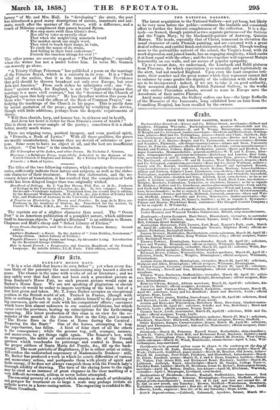arts.
BARKER'S HORSE RACE.
" It is a wise child that knows its own father" ; yet when every fea- ture blabs of the paternity the most uncliseerning may hazard a shrewd guess. The chance is the same with works of art or literature ; and we may safely aver that had there not been such a precedent picture as Rosa Bonheur'a Horse Fair, no such present picture would exist as Barker's Horse Race. We are not speaking of plagiarism or slavish imitation-it would be unfair to impute anything of the kind; but of a first hint given and taken. Mr. T. Jones Barker occupies an exceptional position in the British world of art. Trained in France' (though with little or nothing French in style,) he addicts himself to the painting of big canvasses, quite out of scale with his compatriots' efforts; canvasses which leave him almost unknown in our annual exhibitions, but which career over the provinces, beating up subscriptions for the forthcoming engraving. His latest production of this class is on view for the re- mainder of the month at the Auction Mart in the City, and is named " The Horse Race in the Corso at Rome during the Carnival : Preparing for the Start." One of the horses, attempting to leap the rope-barrier, has fallen. A kind of false start of all the others is the consequence ; while the grooms tug, yell, scamper, menace, and manoeuvre, to get things right again. The Senator's box, with its occupants, the melee of carnival-masquers, a file of the French la which vouchsafes its patronage and control to Rome, and the proper edifices of Santa Maria del Popolo, &o., fill up the back- ground. The most patriotieof Englishmen, if he is either artist or critic, will confess the undisturbed supremacy of Mademoiselle Bonheur : still, Mr. Barker has produced a work in which he courts difficulties of various and momentary action, and poohpoohs them with plenty of spirit and facile energy, if he does not always vanquish them with the French lady's thorough solidity of drawing. The turn of the shying horse to the right may be cited as an instance of great elegance in the clear marking of a veg difficult movement, seldom or never before attempted.
The essential poverty of a subject which smacks so much of artificiality and gewgaw for treatment on so large a scale may perhaps irritate no Esthetic nerve in a horse-racing nation. The engraving is confided to Mr. William Greatbach,


























 Previous page
Previous page